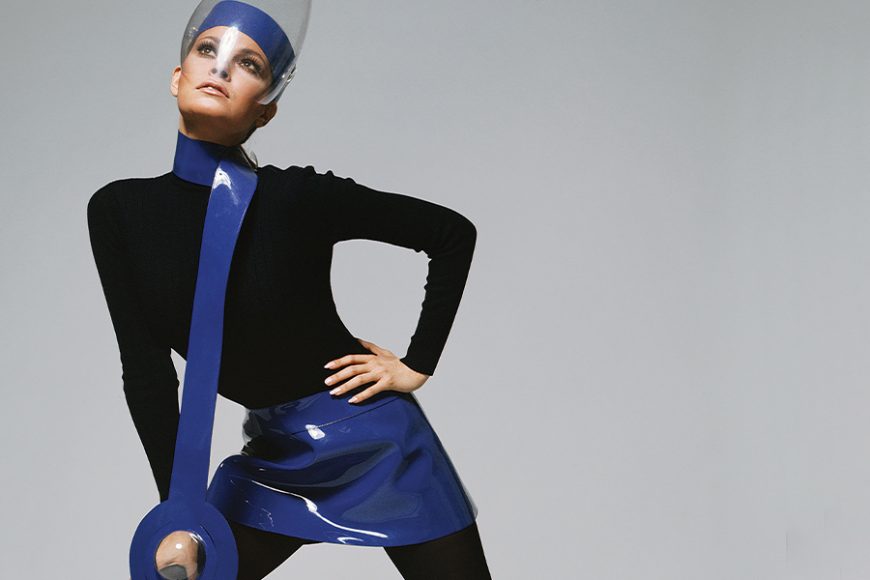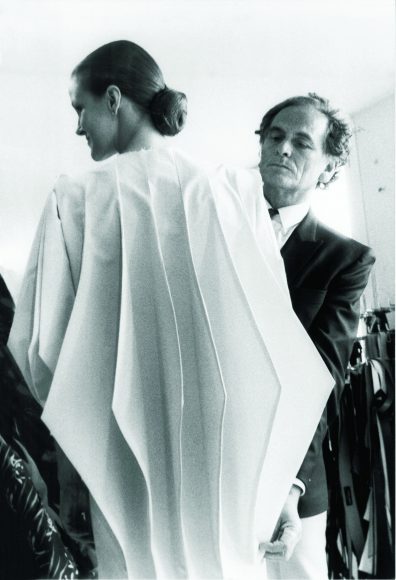The back wall of an elevator that takes visitors to “Pierre Cardin: Future Fashion” features a quote from the legendary French designer.
“My favorite garment is the one I invent for a life that does not yet exist, the world of tomorrow.”
The words not only sum up Cardin’s pioneering Space Age fashions and futuristic designs but also set the tone for what’s to follow in the Brooklyn Museum exhibition rich in both objects and scope.
After all, it’s Cardin’s signature forward vision that is at the heart of “Future Fashion,” an expansive show that’s as vibrant and dazzling as it is thoughtful and historic.
It marks the first New York retrospective in some 40 years to focus on the innovative couturier and is filled with more than 170 objects from 1950 through today. These haute couture and ready-to-wear garments, accessories, photographs, films and other objects are drawn primarily from the Pierre Cardin archive.
Curated by Matthew Yokobosky, senior curator of Fashion and Material Culture, Brooklyn Museum, the exhibition is a tour de force of Cardin’s seven-decade career.
THE CARDIN STORY
Cardin was born in Italy in 1922, moving with his family to central France as a toddler. He would go on to train as a tailor during his teenage years, eventually moving to Paris where he worked briefly at Maison Paquin and Elsa Schiaparelli before joining Christian Dior in 1947. In 1950, Cardin founded his own fashion house. He would go on to be the first couturier to launch a ready-to-wear collection (in 1958) and later would create a groundbreaking unisex line, among other achievements.
Organized chronologically, “Future Fashion” surveys key elements of Cardin’s career, including signature looks (such as the 1960s “Cosmocorps” collection and its “target” dress), his work in trendsetting menswear and fashions created for film and theater. Hats, bags, jewelry and sunglasses are also featured, most dramatically in a wall devoted to hats that creates a striking moment.
The exhibition also includes Cardin’s work beyond fashion, offering a look into his furniture, lighting and industrial design.
“Pierre Cardin is a name that is know all over the world,” Yokobosky said during press preview remarks, noting that Cardin was “such a disruptor in his field.”
Cardin became known for pushing boundaries in design as well as business as one of the first European designers to show in the Far East and also one who would license his name to products distributed around the globe.
That latter effort, it turns out, provided a young Yokobosky an introduction to Cardin. When working on the Jean-Paul Gaultier exhibition (2013-2014) at the museum, Yokobosky says a video of Gaultier working at Pierre Cardin (where Gaultier began his career) sparked a memory. The segment, he says, took him “back to the 1970s, when I received a Pierre Cardin cologne and soap-on-a-rope for the holidays.”
A SINGULAR APPROACH
Yes, the Cardin name graced numerous products from pens to perfumes — and prompted some to question the effect on the brand’s credibility — but the core has always been the fashions that reflected his bold approach and aesthetic.
Geometric silhouettes interpreted in unconventional materials (plastics, Plexiglas and LED lighting) were among the designs often spotted on international stars from Brigitte Bardot to Alain Delon, Raquel Welch to Lauren Bacall and even style icon Jacqueline Kennedy.
The enduring influence of the Space Race on Cardin — the exhibition was timed to open on the 50th anniversary of the Apollo moon landing — is also reflected throughout the show, sometimes quite playfully as in the cartoon clip from “The Jetsons,” with Jane Jetson showing off her “Pierre ‘Martin’ original gown.”
Rounding it out are fashions created for film and theater plus clips from some of Cardin’s pivotal fashion shows held at, for example, the Great Wall of China (1979) and Red Square in Moscow (1991).
Walking through the galleries, it’s easy to be captivated by something at nearly every turn, from a sleek black evening ensemble featuring a dress with “parabolic” shoulders and hat that creates a memorable silhouette to a statement-making geometric handbag in green leather. Catching the eye at another point is a case full of avant-garde shoe designs in a rainbow of colors and then, the sheer artistry of a selection of 1965 Vogue pages. These feature Norman Parkinson photographs of models in Pierre Cardin dresses with a backdrop of Gustav Klimt paintings then on display in London. Another highlight to be sure is an entire gallery that sparkles in reflection of Cardin’s fascination with the night sky, with several of the fashions perched overhead and all surrounded by evocative lighting and music.
In a further nod to Cardin — and his ownership of the iconic restaurant Maxim’s of Paris — the Brooklyn Museum’s restaurant, The Norm, has been transformed into Maxim’s at The Norm for the run of the Cardin exhibition. Visitors can immerse themselves in both décor inspired by the Parisian dining destination and savor a special food-and-drink menu created as an ode to French cuisine in general and Maxim’s in particular.
From fashions to food, visitors will no doubt find his or her favorites as they delve into the ever-growing Cardin legacy.
Cardin is now 97 and, as Yokobosky shared, “still continues to design and remain curious about what’s next.”
As are we.
“Pierre Cardin: Future Fashion” continues through Jan. 5 at the Brooklyn Museum at 200 Eastern Parkway. Admission is by timed ticket, with advance purchase recommended. For more, visit brooklynmuseum.org.






